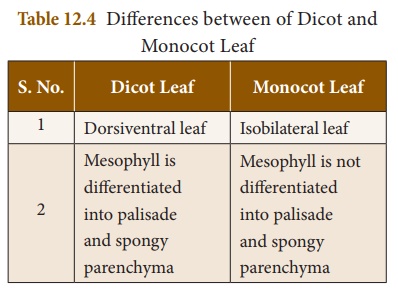Chapter: 10th Science : Chapter 12 : Anatomy and Plant Physiology
Internal Structure of Dicot or Dorsiventral Leaf (Mango)
Internal Structure of Dicot
or Dorsiventral Leaf (Mango)
The transverse section
of leaf shows the following structures.

(i) Upper epidermis: This is the outermost layer made of single layered parenchymatous cells without intercellular spaces. The outer wall of the cells are cuticularized. Stomata are less in number.
(ii) Lower epidermis: It is a single layer of parenchymatous
cells with a thin cuticle. It contains numerous stomata. Chloroplasts are
present only in guard cells. The lower epidermis helps in the exchange of
gases. The loss of water vapour is facilitated through this chamber.
(iii) Mesophyll: The tissue present between the upper and
lower epidermis is called mesophyll. It is differentiated into Palisade
parenchyma and Spongy parenchyma.
a) Palisade parenchyma: It is found just below the upper
epidermis. The cells are elongated. These cells have more number of
chloroplasts. The cells do not have intercellular spaces and they take part in
photosynthesis.
b) Spongy parenchyma: It is found below the palisade parenchyma
tissue. Cells are almost spherical or oval and are irregularly arranged. Cells
have intercellular spaces. It helps in gaseous exchange.
(iv) Vascular
bundles: Vascular bundle of mid-rib is larger. Vascular bundles are
conjoint, collateral and closed. Each vascular bundle is surrounded by a sheath
of parenchymatous cells called bundle sheath. Each vascular bundle consists
of xylem lying towards the upper epidermis and phloem towards the lower
epidermis.
Differences between of Dicot and Monocot Leaf

Related Topics